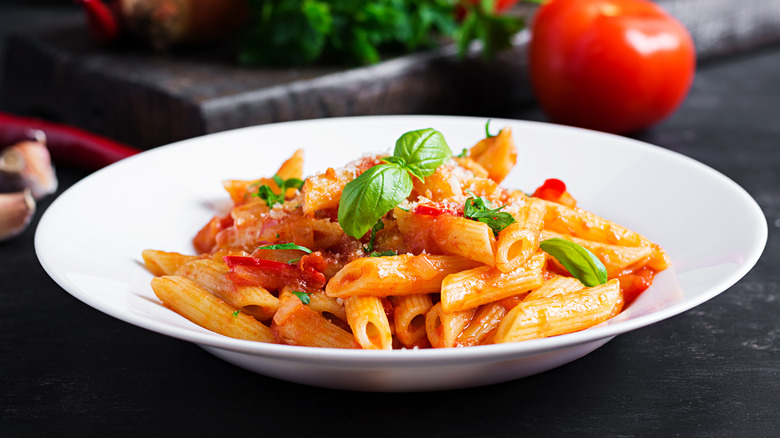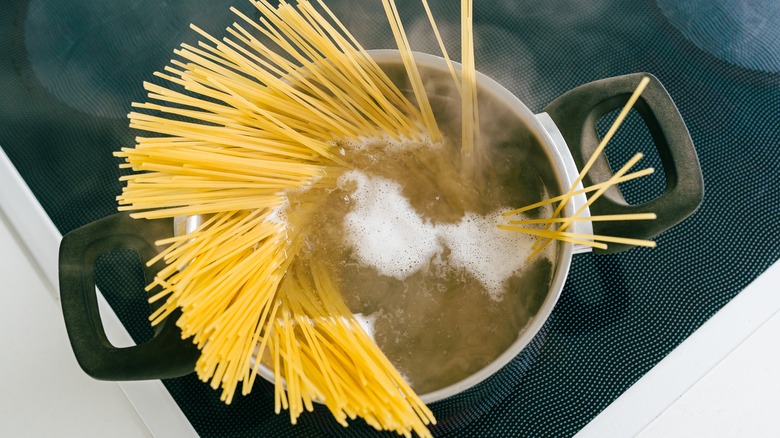The Easiest Way To Cook Pasta Without Wasting Energy
All over the world, people are feeling the sting of inflation and increasingly high bills. Faced with rising utility prices, Italian physicist Giorgio Parisi began worrying whether he and his fellow countrymen could continue enjoying all the pasta they love. According to Science Alert, cooking a single 100-gram serving of pasta in a liter of boiling water requires one megajoule of energy, which equates to a power bill of about 15 cents if you're using an electric stovetop (for a gas stove, it's about nine cents). This might not seem like a lot, but when you consider the fact that almost 17 million tons of pasta were produced in 2022 (according to the International Pasta Organization) — that's over 150 billion servings. And it should be pretty obvious which country eats the most pasta.
Parisi, a co-winner of the 2021 Nobel Prize in physics, believes that he found the solution to this problem. In a 2022 Facebook post, he shared a more energy-efficient method of cooking pasta originally conceived by Italian architect Alessandro Busiri Vici. Instead of keeping the stove on throughout the whole cooking process, Vici and Parisi suggest bringing a pot of water to a boil, adding pasta, then killing the heat and placing a lid on the pot to trap the steam. Thus, you only use enough power to start the water-boiling and let residual heat finish the job. From a physics standpoint, it makes perfect sense, but in the eyes of Italian chefs, it's an entirely different matter.
Breaking down Parisi's pasta cooking method
After bringing a pot of water to a boil, Giorgio Parisi's method entails adding the pasta, waiting two minutes, then turning off the heat and covering the pot. He recommends cooking the pasta one minute longer than the package instructions, after which you can take off the lid and drain it (saving some water to finish the pasta in a pan). Parisi estimates that this will save eight minutes of energy consumption compared to boiling pasta all the way through. With Forbes reporting that Italians eat about 23.5 kilograms (just over 50 pounds) of pasta per capita annually, shifting to this method could cut each individual's carbon emissions by over 13 kilograms each year.
The key to cooking pasta this way is keeping a tight lid on the pot to retain the residual heat left from bringing the water to a boil. This is similar to the concept of carryover cooking, which is frequently used in cooking meat. In carryover cooking, you remove the food from its heat source when it is still a bit underdone and let the residual heat complete the cooking process.
Parisi and Alessandro Busiri Vici received harsh criticism from Italy's culinary elite, with Michelin-starred chef Antonello Colonna telling la Repubblica that cooking pasta off the heat will make it rubbery. On the other hand, Unione Pasta, an association of Italian pasta producers, endorsed the method, emphasizing the potential energy savings.
There's another energy-saving way to cook pasta
Giorgio Parisi and Alessandro Busiri Vici's idea to cook pasta off the heat proved more controversial than either man likely imagined, but there is another way to cook pasta to save both energy and water. Antonello Colonna, the very same chef who lambasted Parisi's off-heat method in la Repubblica, suggested the alternative cold-water cooking method for pasta. This technique not only cuts down on energy, but cooking time as well.
The cold-water method involves adding pasta to a pot with cold water (or another pasta cooking liquid). The surface of the water should be an inch or two above the pasta. Turn on the heat, and by the time the pot comes to a boil, the pasta will already be partially hydrated. This method has some limits, however. If you're using a long, thin pasta, like spaghetti or linguine, the noodles can stick together easily. You could try the cold-water method in a wide skillet, but the Parisi method would still be the easiest route to take if you're looking to save energy.


